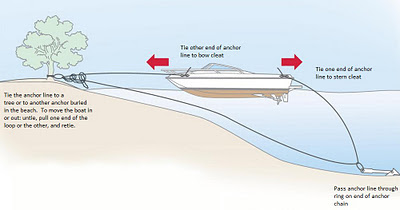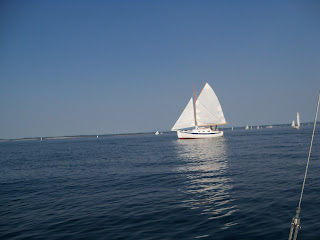This is my favorite method:
- Tie one end of the anchor line to the bow cleat.
- Run the anchor line through a ring on the end of the anchor chain.
- Tie the other end of the anchor line to the stern cleat.
- Drop the anchor a bit offshore.
- Move the boat close to shore, to knee deep water or right to the beach.
- Step out, grab the shore anchor and the anchor line loop and take them ashore.
- Bury the shore anchor in the beach and tie the anchor line to it as shown below. Or tie to a log or tree.
- To reel the boat in and out, untie, pull one side of the anchor line loop or the other, and retie.
 |
| Tie the anchor line to the shore anchor |
- Securely tie the anchor line to your shore anchor as shown. That way, if your other anchor were to slip or the anchor line were to break, you would not lose the boat because it would still be attached to the shore anchor.
- The boat can be oriented with the bow pointed to shore or the stern. The system works either way. You can even change the direction later if you prefer.
- You need plenty of anchor line since we're forming a long loop.
- I prefer a sinking line over floating to prevent someone cutting it with their prop.
- I recommend using large, smooth stainless steel rings instead of blocks on the end of the anchor chain to prevent them from jamming with rocks, sand or seaweed.
- There is no need for an anchor chain on the shore anchor
- This is a short-term anchoring solution. Do not rely on it for long-term moorage.
- If you sleep onboard your boat: 1) loop the anchor line through a ring on your shore anchor instead of tying it. 2) Keep the loop onboard (the length of anchor line lying on the bottom under the boat) so you can use it to pull yourself to and from shore. Cleat it to prevent the boat from reeling itself in or out. 3) You'll need an even longer anchor line since you'll reside further offshore and will still want to maintain scope on your anchor.


































































